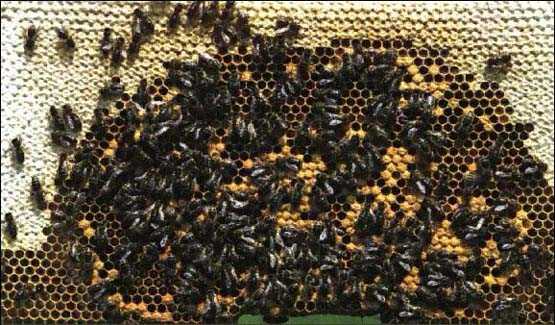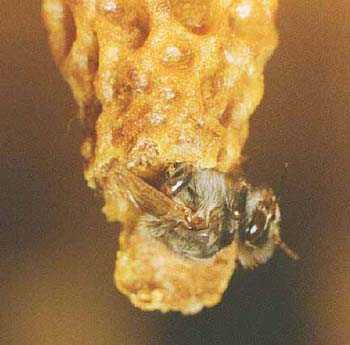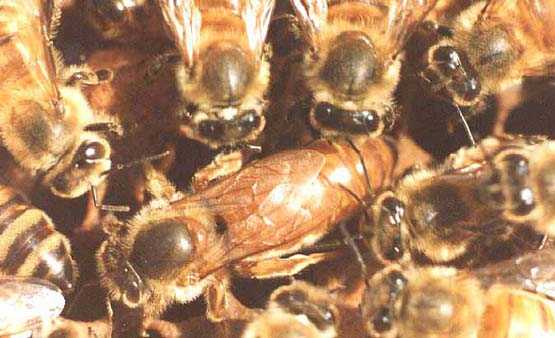|
Everything
starts with a wedding dance, celebrated in the open air on a pleasant and warm
spring day when the sun is out.
The
new-born queen comes out of the hive into the sunlight for the first and perhaps
the last time in her life.
She
wins her crown in a mortal duel with at least one of her sisters and then eats
her rival, sucking the insides of the dead body (nothing is wasted in the bee
society).
The
newly crowned virgin queen flies in circles up and down, high and away.
Soon
she starts to be followed by an indeterminate number of drones, who have the
biggest and most perfect eyes of the bee-family, with at least 13,000 facets
in each one of them (about 4.900 for the queen, in her smaller head, 6,500 for
the eye of the common bee, on average).
They
also have larger wings, slightly longer then their own body. According to most
biologist and beekeepers, the reason is exclusively for the purpose of spotting
and reaching the queen in her wedding ceremony - the sooner the better, before
other drones do.
After
all, this is the only work that they will ever do in their entire life, and
apparently the only reason for their existence is because drones don’t have
any of the special organs that the common labour-bees possess to collect pollen,
nectar and water, or to produce honey and wax, and they are either warriors,
as his sister are, because they haven’t got the jaws or the sting for it.
The
drones are completely useless to the hive society once the queen has been fecundated
(some modern scientists say that the drones in the hive stimulate the labour-bees
in their work and make them more active, with pheromones and body heat).
The
ones that haven’t succeeded in their love affairs remain in the hive doing nothing
apart from eating, just going out a short while trying to spot another queen
flying by. At the end of the honey-harvest season - by the end of autumn - as
each one of the drones eats daily the honey of about the production of six labour-bees,
exclusively for saving reasons before the hibernation, they will all be killed
or expelled from the hive by the bee-community and another generation of them
will be created by the queen for next spring.
The
drone that has been able to reach and conquer the queen in her wedding flight,
like an opera hero, will drop dead after showing her all his passionate love.
This
is so because his sexual organ breaks off and remains inside of hers with the
copulation, leaving about a million spermatozoids that she will keep in a special
organ to be used later, one by one, to fecundate her eggs. This means his instant
death, just the same as a common bee using and losing her sting.
The
queen will return to be pampered by her court inside of the hive, with part
of his sperm as a small white filament hanging from the end of her abdomen.
This is the best proof for the beekeeper that everything went OK. The ceremony
has been successfully completed, the queen is fecundated and the ritual is over.
Once
the new fecundated queen returns to the hive, as only one queen can reign in
it, normally the old queen, her mother, gets ready to leave it with about half
of the population of the colony. The ones that want to stay with the old queen
all walk out of the hive, forming a crowded group by its entrance waiting for
her to be ready. Then they all fly away together to create a new colony elsewhere.
This is when the new swarms are formed. The other alternative is another mortal
duel between mother and daughter. On very few occasions - when the queen mother
is rather old, more than three years - she is allowed to stay and die in her
own primitive hive.
Now
we have a new and only queen in the hive, everything goes back to “normal”,
life recovers its routine.
For
the first two or three days nothing happens, then the queen’s abdomen starts
growing, she shows beautiful colours and all her splendour as a young mother,
she goes around the panel nest, inspecting the good conditions of the cells.
When
she makes sure everything is in good condition, she goes to the middle of the
panel nest and starts laying her eggs. This is always in the central cells and
around them in circles, always only one egg per cell.
When
she reaches a larger cell (this is a cell for a drone) then she lays - at her
own will - an egg without using the drones’ spermatozoids, so the egg is not
fecundated. That means only a drone can come out of it; the rest of the cells
will be filled with an egg each, the same eggs for the labour-bees or for queens,
though the queen’s cells are also bigger.
A
fecundated egg of 1.5mm is put inside a standard cell three days after a larva
will be born. It starts to be fed straight away by her particular nurse with
a pre-digested very rich jelly that young bees, up to three weeks, produce in
special glands in their heads.
It
is a very especial aliment. It is what makes the difference between a normal
bee and a queen. The difference is not in the egg, but in what the larva eats.
This very special jelly: the queen will eat it all her life and she can live
for five years. A normal bee just lives six to seven weeks when they are active
and just will eat it for the first days of her life, therefore, this jelly is
known as the queen’s jelly or “Royal jelly”.
For
two or three days, the larva eats constantly this especial jelly and grows very
fast. After the third day, the larva will eat pollen and nectar; in five days
its weight will go from 0.1mg to 157mg, changing several times its jacket, and
the larva will began to make a thin cocoon. Then, her nurse will cover the cell
with a porous lid made of pollen and wax and a nymph will develop in it.
Twenty-one
days after laying the egg, a complete newborn bee gnaws the cell cover and comes
out to life, after passing through a complete metamorphosis.
The
first day she is moving around the hive, meeting the rest of the family.
Twenty-four hours later, the task of the labour-bee has begun. She starts cleaning
the new empty cells and on the fourth day she becomes a nurse and will feed
the large larva with her own royal jelly. On the sixth she will feed the younger
larva.
From
the 8th till the 10th, she will be working inside the
hive doing specific jobs. She can work stoking the pollen and nectar collected
by her older sisters, or she will be a ventilator by beating her wings non-stop.
This is a very important job that young bees do. Two rows of bees, one in front
of the other, all beating their wings at the same time to renew the air inside
the hive and to dry the extra humidity of the pollen or nectar harvest; otherwise
it could be wasted by fermentation. Also when it is very hot, they ventilate
the just-made new wax cells or else they could melt and lose their shape.
During
this time, she can also work as cleaner, removing the dead bodies or the rubbish
and other insects from the hive. Another job they do is to repair the hive and
the panels with propoleos, a kind of resin produce by bees from the new buds
of some plants and trees mixed up with its wax. They use this to fix the panels
to the hive and to glue all the cracks and holes. This is also the age that
she learns how to orient herself and the situation of the hive in the neighbourhood.
About
the 18th day of her existence, the bee starts to produce wax from
special glands situated below her abdomen, in between the lasts four rings of
it. The wax appears as diminutive scales (1,250,000 of them in a kilogram) deep
inside the joints of those rings. She collects them by rubbing the legs up and
down her abdomen, fixing them with leg hairs and takes them up to her mouth,
chewing them to mix with saliva. To make new panels and cells, bees of the same
age work as a team, using specific techniques for it.
Then,
for a few days, she will be a worrier as a guard of the hive. By then, she knows
everybody in her own colony and only they will be allowed inside the hive, any
other stranger of any kind, big or small, will be attacked with ferocity.
When
she is three weeks old, for about twenty-five days, till she dies, is when she
starts her job as a pollen, nectar and water collector. She visits the flowers
and licks the nectar with her long tongue, accumulating it inside a bag in her
digestive tube before it is regurgitated again, experimenting in this process
the first step for its transformation into honey.
She
gets deep inside the flower, covering herself with pollen, and as she normally
visits just one type of flower at a time, it is when her priceless job pollinating
other plants is done.
To
collect her pollen, they brush the stamen with their jaws. Bees also possess
special organs in their back legs, like special hairy brushes. They put the
pollen in a special bag and form a couple of small pollen balls, big enough
to be seen, hanging from them when they fly around collecting it. When she returns
to the hive, she stocks her own harvest or gives it to one of the youngsters
to do this job. She tells the rest of the collectors, by performing a special
dance, from where she has collected her harvest. The new honey is put inside
the cell and closed as soon as it is full, to be eaten in the winter or to be
collected by the beekeeper.

A Cross
Section of a Bee-Society

A New-Born
Queen Bee

A Queen
Bee Surrounded by Worker Bees
(To
be continued) |